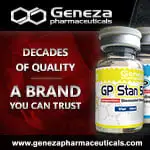Joint Products
QFS has come out with three injectible products for joint soreness that I feel might be of some use to us.
Image:
http://www.rippedcanadians.ca/userpicts/QFSpolysulphate.jpg
Polysulfated glycosaminoglycan (PSGAG), is a semi-synthetic pharmaceutical prepared by sulfate esterification of glycosaminoglycan molecules. It is chemically similar to the natural glycosaminoglycan of cartilage tissue, making it more than just an anti- inflammatory medication for joint trauma; it is a medical therapy that not only treats the symptoms but actually treats the underlying processes threatening to turn joint injury into joint degeneration.
Administered by intramuscular injection, PSGAG acts to break the degenerative cycle while reducing the symptoms of joint disease:
PSGAG inhibits more than a dozen joint-damaging enzymes.
Decreases inflammation and pain by inhibiting prostaglandin-E2 synthesis, decreasing the release of toxic-free radicals, and inhibiting the complement cascade.
Promotes the production of new hyaluronate in the synovial fluid to help lubricate the joint (doubles the concentration in 48 hours) and facilitate cartilage nutrition, and stimulates chondrocytes to synthesize new cartilage components.
In clinical trials, peak therapeutic levels were achieved in the synovial fluid and cartilage of the joint within two hours of intramuscular injection, and levels were 33% higher where PSGAG'S presence was most critical: in inflamed versus normal joints.
The efficacy and safety of PSGAG in the treatment of synovitis and degenerative joint disease of the carpus has been well supported in clinical trials and in actual field use:
In clinical field trials involving 39 horses with naturally-occuring traumatic or degenerative joint disease, investigators rated the response good-to-excellent in 90% of the horses treated with intra-articular PSGAG and 88% in horses treated intramuscularly.
PSGAG has been proven safe. Subacute toxicity studies at five times the recommended intramuscular dose for 3 times the recommended duration of therapy resulted in no signs of toxicity.
Administration: An initial 7-dose series is recommended: 250 mg intramuscularly every 4 days for 7 injections.
PSGAG is presented in a 5ml vial containing 100mg/ml of polysulphated glycosaminoglycan
------------------------------------------------------------------------ --------
------------------------------------------------------------------------ --------
Image:
http://www.rippedcanadians.ca/userpicts/qfsSodiumhyal.jpg
Sodium hyaluronate (hyaluronic acid—HA) products have been used successfully for years to treat joint disease in several species including the horse. HA is a normal component of joint fluid and cartilage and serves many functions, one of which is to "lubricate" the soft tissue structures of the joint and decrease inflammation. Until recently, HA products were given only as intra-articular injections, directly into the joint space. Now there is an HA preparation that can be given intramuscularly (I.M.) and has shown beneficial results.
Although the mechanism of action of HA is not entirely understood, it is recognized that sodium hyaluronate decreases synovial fluid inflammatory mediators (destructive enzymes) which may have a degradative effect upon articular cartilage.
In addition to the anti-inflammatory actions, HA acts as a lubricating substance within the joint and provides a "protective barrier" over the synovial membrane.
Sodium Hyaluronate is the joint disease therapy that helps stop acute damage before it becomes chronic. Sodium Hyaluronate (hyaluronic acid), is the same polysaccharide present in normal joint fluid to protect and lubricate joint cartilage and soft tissues. Sodium Hyaluronate is produced by a biofermentation process, resulting in such purity that it can be given intramuscularly for immediate bioavailability.
A Colorado State University study* demonstrated systemic administration of Sodium Hyaluronate significantly decreased the synovial fluid concentrations of prostaglandins, glycosaminoglycan (GAG), and total protein that are associated with inflammatory joint disease in the horse. The systemic administration of Sodium Hyaluronate also decreased the severity of cellular infiltration and vascularity in the synovial membrane (i.e., decreased inflammation at the synovial membrane level). This study demonstrates that systemic administration of Sodium Hyaluronate decreases inflammation, products associated with inflammation, and the degree of lameness in horses with arthritis (joint inflammation).
Administration: A series of 4 weekly intramuscular injections consisting of 25mg of Sodium Hyaluronate is recommended.
Sodium Hyaluronate is presented in a 5ml vial containing 10mg/ml of sodium hyaluronate
------------------------------------------------------------------------
Image:
http://www.rippedcanadians.ca/userpicts/QFSglucosamine.jpg
I think we all know the effectiveness of glucosamine and now the people at QFS pharmaceuticals have made an injectible form and I say its about time and has been long over due.
Administration: An initial 7-dose series is recommended: 750 mg intramuscularly every 4 days for 7 injections.
Glucosamine HCl is presented in a 10ml vial containing 300mg/ml of glucosamine hydrochloride


 Please Scroll Down to See Forums Below
Please Scroll Down to See Forums Below 










